The Blast Furnace
Since building this subwoofer, my house has begun cracking up. I blame the clay soil and climate change, but secretly fear that the sub is slowly pulverising the sandstone piers. The price we pay for our passions....
- Twin 10 inch Jaycar CS-2274 Drivers
- 350W (4ohm) Jaycar AMP
- 130 Litre 4.6cu.ft enclosure - 68kg - 150lb
- 1030H * 740W * 500D
- Tuning Frequency 28 Hz
- Twin 160mm external ports
- WinISD Calculated Peak Output 113 dB
- Measured Avg Output (Complex Sound) before distortion 107db
- Estimated cost $900 Australian
For this creation I wanted something a little different. The Blast Furnace is so named because it is reminiscent
of blast furnace at the steelworks I worked at a some years ago
Consisting of a powerhead , housing two drivers, and linked via a transfer port to a lower chamber which makes
up the required volume, this speaker will give an
extra 7db over the Sidewinder
Two external ports exit the powerhead at the sides and run through the lower chamber to exit at the front.
These ports do not open into the lower chamber but are supported by it. The amplifier is mounted at the back of the lower chamber,
with the controls and infra-red receiver at the front
Jaycar's 350W amplifier delivers 240W into 8ohms as presented by the two drivers in series
It was hoped to disable the 6db boost on this amp as it seemed similar to the
Parts Express models from the USA.
When the back of the amp was opened and compared it to the photos from the net, it was too different!
Since then, these instructions have become available, but I didn't bother.
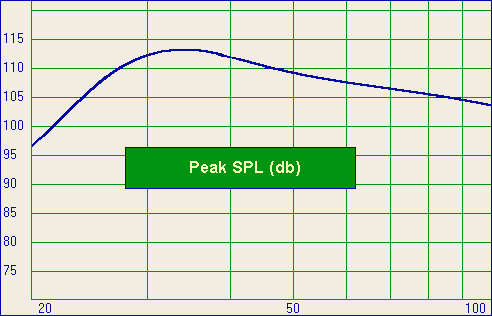
Two 160mm ports mean absolutely no port noise. Both ends of the ports were flared by 10mm using a rollover bit in the router.
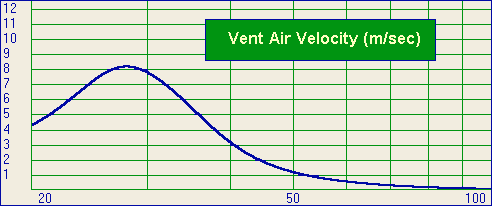
Flare-it screenshot shows that there is actually a bit of port headroom in this design
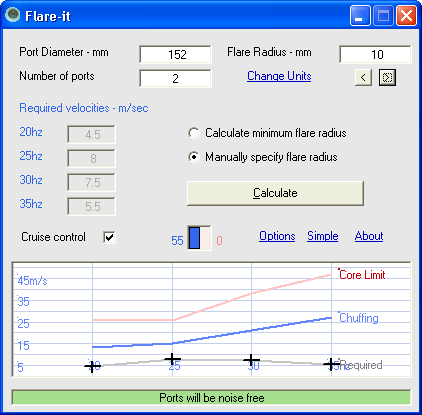
Because the amp has +6db boost at 35Hz, power is not as much in the excursion critical range of 25Hz and lower. No hi-pass filter is required for this unit
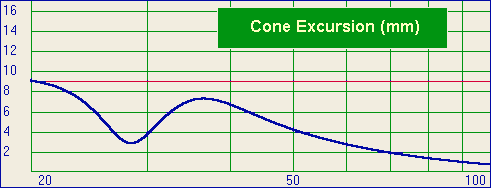
So how does the Blast Furnace compare to some commercial subs?
Data as published by Widescreen Review Issues 36 & 49 I found this comparison on SPL performance of selected subwoofers on the web in table format. I have graphed it to see how DIY fares in comparison to "store bought" The source article is unavailable unless you subscribe to Widescreen Review, but from researching each of the suppliers, it seems that these speakers are about 1999 vintage
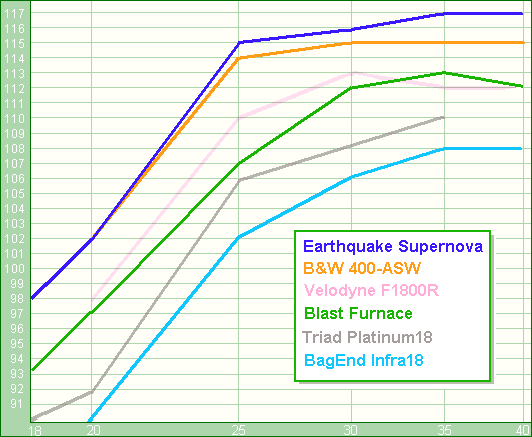
| Brand and Model | Cost $US | Comments |
| Earthquake Supernova 15inch | $2,999 | Passive Radiator tuned to 17Hz 580W RMS |
| B&W 400-ASW 15inch | $3,000 | Obsolete no details available |
| Velodyne F1800R 18inch | $1,999 | Obsolete. Their recommended replacement is DD15 or DD18, sealed, with 1250W RMS (3000W Peak) |
| Triad Platinum 18 18inch | $2,200 | Sealed 500W RMS |
| Bag End Infra18 18inch | $1,495 | Sealed 400W RMS - Note: The Bag End Infra series are intended to be driven with an equaliser that boosts the bottom end. This one was obviously tested without it! |
As you can see the 300w twin-10inch ported Blast furnace holds up fairly well!
Tuning Frequency Study
A very easy test was done to find out what more bass extension would be like. Blanking off one of the ports lowers the port tuning frequency from 28hz to 18.4hz and increase box volume from 130 litres to 150 litres.
WinISD gives the following prediction of SPL. (Original in red, one-port in green)
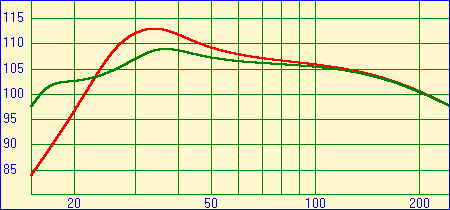
10dB better @18hz, equal @23hz and 5dB worse @30hz
A quick check of other changes which could affect the sound reveals that Port air velocity rises from 8 m/sec to 11 m/sec. Group delay actually falls in the working range although it peaks further down the range at 62 msec @ 16hz as opposed to the original value of 36 msec @ 27hz. These changes can be ignored
So how did it sound?
As expected, testing with the normal suite of DVDs, the study produced mixed results depending on the frequencies involved.
The standout performer was Star Wars II Chapter3, where the arrival of the starship
produced sounds I had never heard before.
This title gives a glimpse of how awesome a sub 20hz mix can be!
However all the rest of my DVDs were less impressive,
indicating that their LFE content was 25hz upwards.
An interesting one was the first Lord of the Rings movie, The Fellowship of the Ring. The loudest sequence is in chapter 29 where the Troll first appears. With the modifications in place, the result was a little lower in SPL, but there were problems with cone excursion. Looking at the comparison below, I would guess that this sequence is around the area of highest cone excursion ie 32hz

Cone excursion comparison showing possible problem with extended bass design
Another interesting one was Terminator3 - the crane chase sequence. With the mods, there was virtually no subwoofer action apart from the main crash which was present but not as loud.
In conclusion, the additional bass extension is very desirable
for those few DVDs that support it. It seems that most DVDs are mixed with the content optimised for the mass market.
With not much below 25hz, the tradeoff in SPL above 25hz is too high a price to pay at the moment
However, that said, I could do some equalisation if I had 6dB up my sleeve - hmm, a second one
would do it, although I do have some concerns about the seismic resilience of my 100yr old house.
Its already been through two earthquakes.....
Postscript: A pair of Buddy Subs have been built to use this alignment
Blast Furnace Gallery
Clamping of transfer port whilst glue dries
You can't have too many clamps. Eight clamps were required to hold the two layers of the transfer port for gluing. Cling wrap comes in handy to stop glue sticking to unwanted surfaces
Preliminary assembly
19mm MDF was used for this speaker and is much nicer to work than the chipboard of earlier models,
although the router dust is apparently quite toxic meaning a respirator is needed
An internal frame was made from strips of MDF which allowed everything to be screwed together without glue
at this stage. Once all the panels are finished, they are glued and screwed one at a time.
After the glue dries, all internal seams are sealed with gap sealant to prevent any possible air leaks. The external seams and screw holes are filled with putty and then 3 coats of polyeurathane is applied
Bottom view of power head
The transfer port will couple the two chambers together and is not glued in place at this stage
Lower chamber with bottom removed
Visible in this view are the rebated port openings which allow the glue more surface area to work on. The cutout at the back is for the amp and the one at the front is for the controls
Shelf brace - powerhead
Guess who just bought a router!
A central shelf brace is used to make the powerhead more rigid.
Because the ports exit from the centre of the sides, cutouts had to be made for airflow.
All internal edges were cleaned up with the rollover bit so there are no sharp edges to cause any whistling
Bottom view of powerhead
The shelf brace is rebated into front and back panels and has cutouts for airflow into the side ports. Also, just visible are the screws for the top which were screwed from the inside so there were no visible holes to be filled
Top view of transfer port
This view of the powerhead with the sides removed, shows the top edge of the transfer port which, along with the bottom edge, was smoothed with the rollover bit. The port is still removable at this stage
Concept session
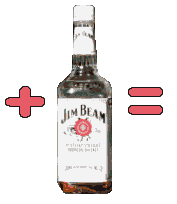
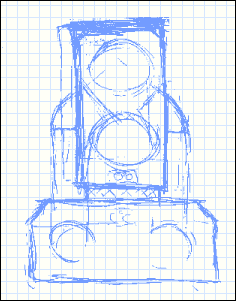
Using the Sidewinder as a sample power head, and some large pipes to hold everything in place, various ideas were tried out. With creative assistance supplied courtesy of Uncle Jim, the Blast Furnace was born
Rebates and edge bracing
The front panel was made out of double thickness of MDF glued together. The larger radius was cut first and then the smaller cut through
Closeup - transfer port
Circle cutting jig
To cut circles, a homemade jig was constructed using the slides that came with the router, and took about 4 hours to make. The pivot point is just visible under router. The angle piece was rivited to the baseplate, which was made out of some thick aluminium sheet that had been saved for something special.
I recently had to cut a hole for an 18 inch driver and found that my jig was too small. This is what I used as an emergency single use jig. With care, it worked fine!
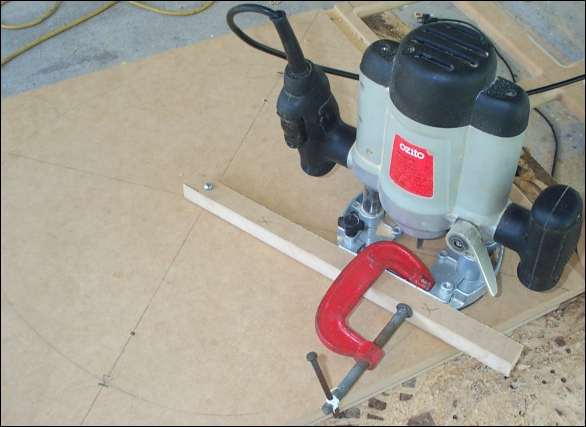
Lower chamber
These braces were cut with the router and given a rollover edge, then glued into position
View through port opening
The shelf brace detail and location can be seen here. On the far side, you can see where the inside face of the port opening is rebated to increase the surface area for the glue
Nearly There..
Three coats of Polyeurathane, before the ill-advised flirtation with Scandanavian Oil
Completed
Here it is in all it's glory! The background has been removed and the shadow added, but this is the photo taken on the back porch
Adapted
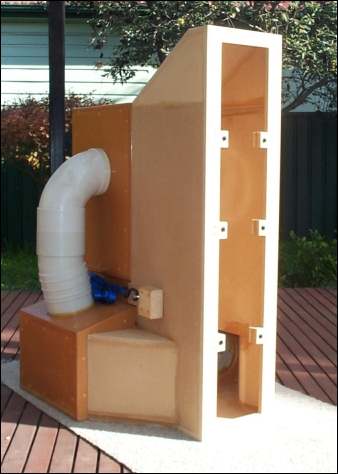
The sub was recently sold but the new owner wanted to mount it behind a wall (shock horror!). In addition, the opening had to match the existing in-wall sonance main speakers. This adapter shroud was made up.
Port section
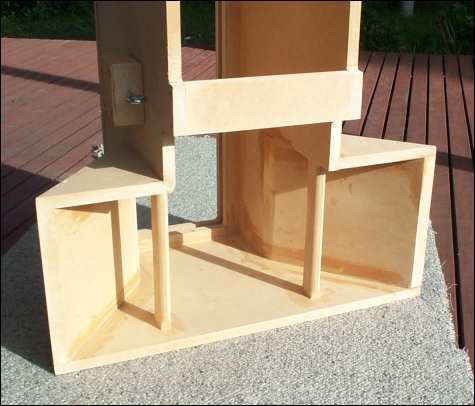
The output from the ports needed to be channelled inwards by this section. The air is compressed horizontally, but has room to expand vertically. Adapter will be sealed to sub using some foam tape and a ratchet tie-down. I had to learn some new router tricks to cut those angles!
Nice Face!
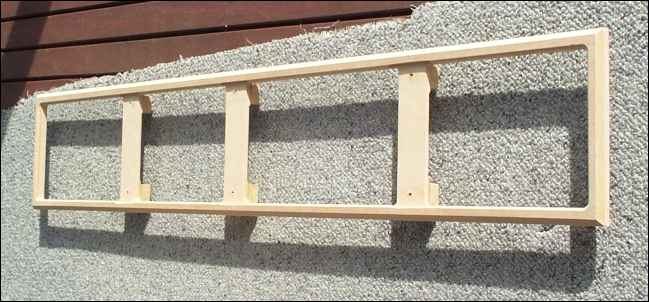
The new owner hopes to purchase a front panel from Sonance to match the mains. Meanwhile this grille is the same size. To facilitate airflow, it is as narrow as possible, meaning some cross braces were needed to stop the tension in the grille cloth from distorting the shape. These were rebated to keep them clear of the cloth, thus avoiding any "grille slap".
Grille clips
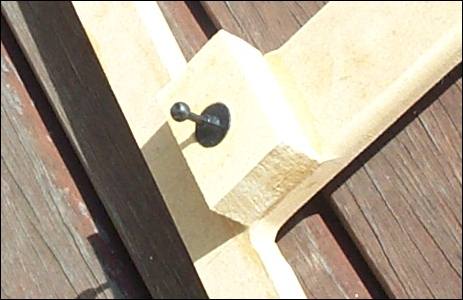
The grill is mounted on standoff blocks to fit through the drywall. The other half of the clips is mounted in blocks that can be unscrewed and discarded when the Sonance panel arrives.
